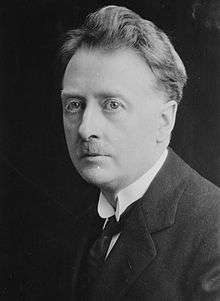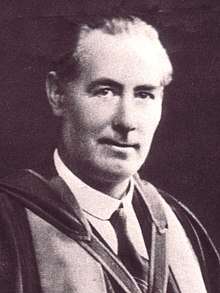1932 Irish general election
The 1932 Irish general election was held on 16 February 1932, just over two weeks after the dissolution of the Dáil on 29 January. It was the first election held since the Statute of Westminster granted full independence to the Irish Free State a year earlier.
| |||||||||||||||||||||||||||||||||||||||||||||||||
152 of 153 seats in Dáil Éireann 77 seats needed for a majority | |||||||||||||||||||||||||||||||||||||||||||||||||
|---|---|---|---|---|---|---|---|---|---|---|---|---|---|---|---|---|---|---|---|---|---|---|---|---|---|---|---|---|---|---|---|---|---|---|---|---|---|---|---|---|---|---|---|---|---|---|---|---|---|
| Turnout | 76.5% | ||||||||||||||||||||||||||||||||||||||||||||||||
| |||||||||||||||||||||||||||||||||||||||||||||||||
 Percentage of seats gained by each of the three biggest parties, and number of seats gained by smaller parties and independents. | |||||||||||||||||||||||||||||||||||||||||||||||||
| |||||||||||||||||||||||||||||||||||||||||||||||||
The newly elected 153 members of the 7th Dáil assembled at Leinster House on 9 March 1932 when the new President of the Executive Council and Executive Council of the Irish Free State were appointed by Governor-General James McNeill on the nomination of Dáil Éireann.
The general election took place in 30 parliamentary constituencies throughout the Irish Free State for 153 seats in the lower house of parliament, Dáil Éireann. The 1932 general election was one of the most important general elections held in Ireland in the 20th Century, resulting in the Free State's first change of government. Cumann na nGaedheal, which had been the governing party since 1922, was defeated by Fianna Fáil, which became the largest party in the chamber and formed a government with the support of the Labour Party. Fianna Fáil would be the largest party in Dáil Éireann at every general election until 2011.
Cumann na nGaedheal
Cumann na nGaedheal fought the general election on its record of providing ten years of stable government. The party brought stability following the chaos of the Irish Civil War, and provided honest government. However, by 1932 this provision of solid government was wearing thin, particularly since the party had no solution to the collapse in trade which followed the depression of the early 1930s. Instead of offering new policies the party believed that its record in government would be enough to retain power. Cumann na nGaedheal also played the "red card" tactic, describing Fianna Fáil as communists and likening Éamon de Valera to Joseph Stalin.
Fianna Fáil
In comparison to Cumann na nGaedheal, Fianna Fáil had an elaborate election programme, designed to appeal to a wide section of the electorate. It played down its republicanism to avoid alarm, but provided very popular social and economic policies. The party promised to free IRA prisoners, abolish the Oath of allegiance and reduce the powers of the Governor-General and the Senate. It also promised the introduction of protectionist policies, industrial development, self-sufficiency and improvements in housing and social security benefits.[1][2]
Campaign
The election campaign between the two ideologically opposed parties was reasonably peaceful. However, during the campaign the government prosecuted de Valera's newly established newspaper, The Irish Press. The editor was also brought before a military tribunal. This was seen by many as a major blunder and a serious infringement on the belief of freedom of speech. The "red scare" tactics also seemed to backfire on the government, who seemed to have little else to offer the electorate.
Two days before the election, Patrick Reynolds TD (Cumann na nGaedheal, Leitrim–Sligo) was assassinated in Ballinamore by Joseph Leddy. A Garda detective was murdered in the same incident. The poll in Leitrim–Sligo was postponed and Reynolds' widow Mary was elected in his place.[3]
Result
| 7th Irish general election – 16 February 1932[4][5][6] | ||||||||
|---|---|---|---|---|---|---|---|---|
 | ||||||||
| Party | Leader | Seats | ± | % of seats |
First Pref votes |
% FPv | ±% | |
| Fianna Fáil | Éamon de Valera | 72 | +15 | 47.1 | 566,498 | 44.5 | +9.3 | |
| Cumann na nGaedheal | W. T. Cosgrave | 57 | –4 | 37.3 | 449,506 | 35.3 | –3.4 | |
| Labour Party | Thomas J. O'Connell | 7 | –6 | 4.6 | 98,286 | 7.7 | –1.4 | |
| Farmers' Party | Michael Heffernan | 3 | –3 | 1.9 | 22,899 | 1.8 | –4.6 | |
| Irish Worker League | James Larkin | 0 | –1 | 0 | 3,860 | 0.3 | –0.8 | |
| Revolutionary Workers' Groups | 0 | New | 0 | 1,087 | 0.1 | – | ||
| Independent | N/A | 14 | +2 | 9.1 | 131,890 | 10.4 | +2.5 | |
| Spoilt votes | 20,804 | — | — | |||||
| Total | 153 | 0 | 100 | 1,294,830 | 100 | — | ||
| Electorate/Turnout | 1,695,175 | 76.5% | — | |||||
- Fianna Fáil minority government formed.
When the results were known Fianna Fáil was still five seats short of an overall majority, but it still looked like the only party capable of forming a government. Discussions got underway immediately after the election and an agreement was reached in which the Labour Party would support Fianna Fáil. The party now had the necessary votes to form a minority government.
Voting summary
Seats summary
Transition of power
On 9 March 1932 the first change of government in the Irish Free State took place. Many in the country and abroad wondered if the true test of democracy would be passed, whether it would be possible for the men who won a civil war only ten years before to hand over power to their opponents. Similar to when the party first entered the Dáil in 1927, a number of Fianna Fáil TDs had guns in their pockets. However, the feared coup d'état did not take place. W. T. Cosgrave was determined to adhere to the principles of democracy that he had practised while in government. Likewise, the army, Garda Síochána and the civil service all accepted the change of government, despite the fact that they would now be taking orders from men who had been their enemies less than ten years previously. After a brief and uneventful meeting in the Dáil chamber, Éamon de Valera was appointed President of the Executive Council of the Irish Free State by the Governor-General, James McNeill, who had come to Leinster House to make the appointment rather than require de Valera travel to the Viceregal Lodge, formerly a symbol of British rule. Fianna Fáil, a party led by many of the men most closely identified with opposing the existence of the state ten years earlier, were now the party of government. Not only that but the 1932 general election was the beginning of a sixteen-year period in government for Fianna Fáil.
First time TDs
Outgoing TDs
- William Aird (Deceased)
- Edmond Carey (Lost seat)
- Michael Connolly (Lost seat)
- Peter de Loughry (Retired)
- William Kent (Lost seat)
- Michael Óg McFadden (Lost seat)
- Arthur Matthews (Lost seat)
- Thomas Mullins (Retired)
- Martin McDonogh (Lost seat)
- Thomas J. O'Connell (Lost seat)
- Patrick O'Dowd (Lost seat)
References
- Paul Bew, Ellen Hazelkorn, and Henry Patterson, The Dynamics of Irish Politics (London: Lawrence & Wishart, 1989), p. 42
- Peter Mair and Liam Weeks, "The Party System," in Politics in the Republic of Ireland, ed. John Coakley and Michael Gallagher, 4th ed. (New York: Routledge, 2004), p. 140
- https://www.irishtimes.com/news/former-td-was-synonymous-with-fine-gael-in-leitrim-1.1128781
- "7th Dáil 1932 General Election". ElectionsIreland.org. Retrieved 8 April 2009.
- "Dáil elections since 1918". ARK Northern Ireland. Retrieved 13 April 2009.
- Dieter Nohlen & Philip Stöver (2010) Elections in Europe: A data handbook, pp1009-1017 ISBN 978-3-8329-5609-7


